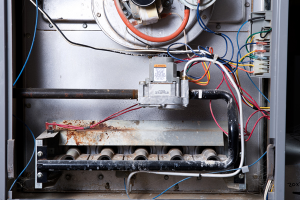How well a furnace will be installed will affect how long will a furnace last. In many cases, we see furnace installation just like any other installation; install it and be done with it. However, we often see inadequate furnace installation. This is one of the most common reasons why furnaces do not reach their 15-year average lifespan. A good installation may add up to 5 years to your furnace. Even more importantly, a bad installation (especially drainage system and fuel lines) is one of the most common reasons why a furnace might stop working after 5 or 10 years.
Well, while everybody knows that regular furnace maintenance is good for prolonging the furnace’s lifespan, not everybody actually invests in regularly scheduling HVAC-certified maintenance.
Lower Thermostat Setting (68°K Is Ideal)
Running any furnace at high operating outputs for prolonged periods of time can reduce the furnace’s lifespan dramatically. A good way to reduce the load a furnace has to output is to lower the temperature setting on our thermostat. Now, the ideal lower temperature would be 68°K in the winter. However, everybody needs to make a compromise between comfort and heating output. If you can decrease the temperature on your thermostat for a degree or two, you’re actively working towards prolonging the years your furnace will function adequately.
Signs It’s Time to Replace a Furnace
Your Home’s Temperature Is Uneven
If you notice significant temperature differences between rooms as you move around your home, that’s an indication that your furnace may be losing its ability to properly circulate heat. Start by checking to make sure you don’t have any leaks in your ducts. If there are no leaks, it might be time for a furnace replacement.

Poor Furnace Installation
Poor installation can affect the lifespan of your furnace for a number of reasons. This is why it’s so important to select a qualified HVAC professional, like your local Carrier expert, to install your system.
- Poorly designed, sized, or sealed duct work impacting airflow can affect your comfort and system efficiency
- Poor drainage system for high efficiency furnaces
- Incorrectly installed fuel lines
Your Furnace Is More than 15 Years Old
Your furnace is probably not going to stop working on the day it turns 15. But in our experience, that is around the time when furnaces start having more problems. Parts start to wear out, energy-efficiency features become less effective, and furnaces that have operated flawlessly in the past start to need more maintenance and servicing to keep them going.
For these reasons, we recommend you start thinking about a new furnace when your existing one is about 15 years old — even if you don’t actually need one yet. Starting early gives you the time to think about the type and size of furnace you want, and to budget accordingly.




